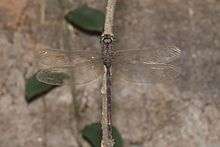Gynacantha dravida
Gynacantha dravida,[2][3][1] also known as Indian duskhawker[4] or brown darner,[5] is a species of dragonfly in the family Aeshnidae. It is found in India and Sri Lanka.[6][1][5]
| Gynacantha dravida | |
|---|---|
 | |
| Dorsal view | |
| Scientific classification | |
| Kingdom: | Animalia |
| Phylum: | Arthropoda |
| Class: | Insecta |
| Order: | Odonata |
| Infraorder: | Anisoptera |
| Family: | Aeshnidae |
| Genus: | Gynacantha |
| Species: | G. dravida |
| Binomial name | |
| Gynacantha dravida Lieftinck, 1960 | |
| Synonyms | |
|
Gynacantha hyalina Selys, 1882 | |
Description and habitat
It is a large dragonfly characterized by its homogeneous colouring of dull browns and greens, by its long and thin anal appendages, and by its crepuscular habits. Its principal food appears to be mosquitoes and microlepidoptera. During the day it rests in dark thickets. Fully matured specimens have bright colours; blues and greens developing very late in life. Young specimens have brown color with some dark shades. Females are exactly similar to the males in colors and markings.[7][8][5]
It is very closely related to G. subinterrupta and it is difficult to distinguish them. But the relative lengths of the superior and inferior anal appendages are different. The inferior being more than one-third the length of superiors in G. dravida and less than one-third in G. subinterrupta.[7]
 Male
Male Female
Female Mating pair
Mating pair Exuvia
Exuvia
See also
- List of odonates of India
- List of odonates of Sri Lanka
- List of odonata of Kerala
References
- Mitra, A.; Dow, R.A. (2010). "Gynacantha dravida". IUCN Red List of Threatened Species. 2010: e.T169173A6575826.
- C.G., Kiran; Raju, David V. (2013). Dragonflies & Damselflies of Kerala. Tropical Institute of Ecological Sciences. p. 83. ISBN 978-81-920269-1-6.
- "World Odonata List". Slater Museum of Natural History. Retrieved 2017-05-30.
- "Indian Duskhawker (Gynacantha dravida)". Retrieved 2017-05-30.
- "Gynacantha dravida Lieftinck, 1960". India Biodiversity Portal. Retrieved 2017-05-30.
- K.A., Subramanian; K.G., Emiliyamma; R., Babu; C., Radhakrishnan; S.S., Talmale (2018). Atlas of Odonata (Insecta) of the Western Ghats, India. Zoological Survey of India. pp. 197–198. ISBN 9788181714954.
- C FC Lt. Fraser (1936). The Fauna of British India, including Ceylon and Burma, Odonata Vol. III. Red Lion Court, Fleet Street, London: Taylor and Francis. pp. 97-100.
- Subramanian, K. A. (2005). Dragonflies and Damselflies of Peninsular India - A Field Guide.
External links


- Animal diversity web
